Anterior and Posterior Circulation of the Brain
Jim Hutchins
Objective 3: Explain the anterior and posterior circulation of the brain.
Arteries of the Head and Neck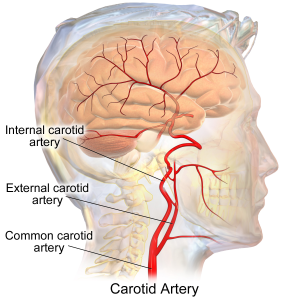
The common carotid artery divides into the external carotid artery, which supplies the face; and the internal carotid artery, which supplies about 3/4 of the blood used by the brain. (The internal carotid and its branches are collectively called the anterior circulation of the brain.)
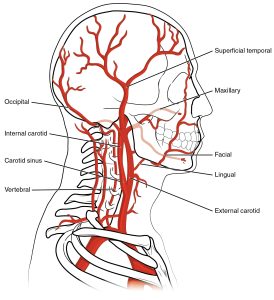
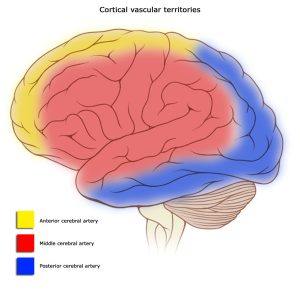
The blood supply to cortex comes from three major arteries:
- the anterior cerebral artery (ACA);
- the middle cerebral artery (MCA);
- the posterior cerebral artery (PCA).
Territories of these three major arteries are shown in the diagram.
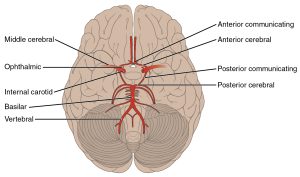
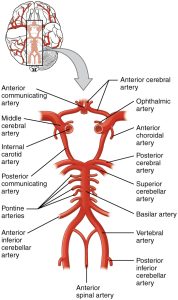
All three of these arteries originate from an anastomosis (joining of blood vessels) at the base of the brain called the Circle of Willis. The Circle of Willis is fed by the anterior circulation, coming from the carotid arteries which rise through the ventral neck; and the posterior circulation, which runs through the vertebral arteries. The vertebral arteries anastomose at the medulla to form the basilar artery.
Branches of the basilar supply the brainstem. The basilar branches at the midbrain level to form the posterior cerebral arteries.
The carotid arteries branch and turn sharply as they reach the base of the brain, forming the anterior and middle cerebral arteries.
All these arteries are connected by a single anterior communicating artery and a pair of posterior communicating arteries, completing the circle.
Media Attributions
- Carotid Arteries © BruceBlaus is licensed under a CC BY (Attribution) license
- Arteries of the head © Betts, J. Gordon; Young, Kelly A.; Wise, James A.; Johnson, Eddie; Poe, Brandon; Kruse, Dean H. Korol, Oksana; Johnson, Jody E.; Womble, Mark & DeSaix, Peter is licensed under a CC BY (Attribution) license
- Cerebral vascular territories © Gaillard, Frank Dr. is licensed under a CC BY-SA (Attribution ShareAlike) license
- Arteries Serving the Brain © Betts, J. Gordon; Young, Kelly A.; Wise, James A.; Johnson, Eddie; Poe, Brandon; Kruse, Dean H. Korol, Oksana; Johnson, Jody E.; Womble, Mark is licensed under a CC BY (Attribution) license
- Circle of Willis © Betts, J. Gordon; Young, Kelly A.; Wise, James A.; Johnson, Eddie; Poe, Brandon; Kruse, Dean H. Korol, Oksana; Johnson, Jody E.; Womble, Mark & DeSaix, Pe is licensed under a CC BY (Attribution) license

